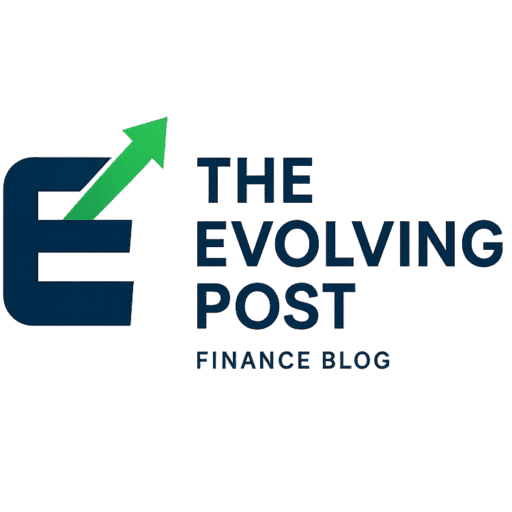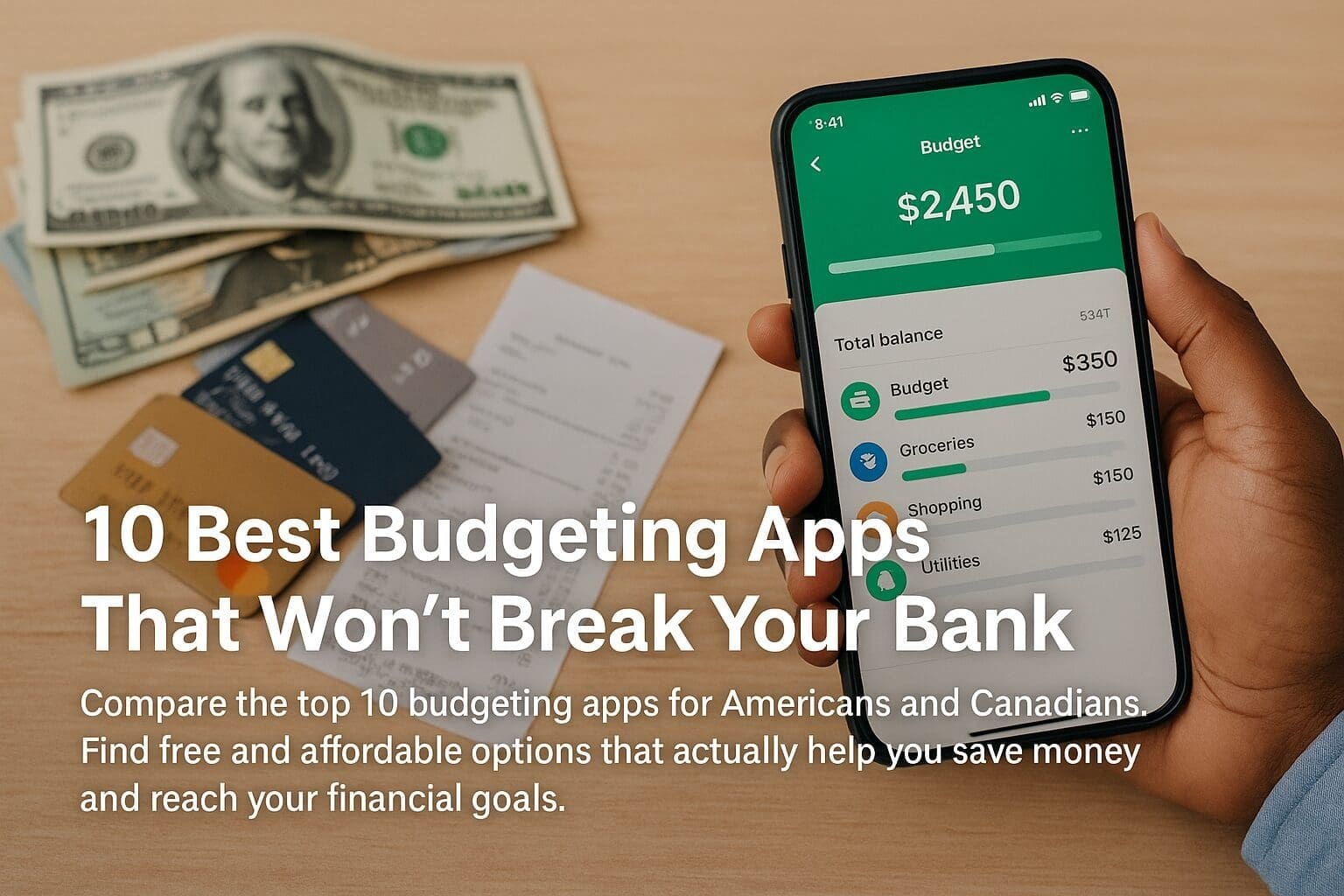Tired of living paycheck to paycheck while paying premium prices for budgeting software? You’re not alone. According to LendingClub’s 2024 Paycheck-to-Paycheck Report, 64% of Americans are living paycheck to paycheck, making affordable budgeting tools more crucial than ever.
After personally testing over 30 budgeting platforms and analyzing user feedback from thousands of Americans and Canadians, I’ve identified the 10 Best Budgeting Apps that deliver real results without draining your wallet. Whether you’re a college student in Toronto managing your first budget or a working parent in Phoenix optimizing family finances, you’ll find the perfect budgeting solution here.
Table of Contentscountabout
- Why Traditional Budgeting Methods Fall Short
- How We Evaluated These Apps
- Top 10 Budgeting Apps Detailed Analysis
- Complete App Comparison Table
- Choosing the Right App for Your Situation
- Canadian Users: Special Considerations
- Security and Privacy Guide
- Implementation Strategy
- Common Mistakes to Avoid
- Frequently Asked Questions
Why Traditional Budgeting Methods Fall Short
The Federal Reserve’s 2024 Report on the Economic Well-Being of U.S. Households reveals that 37% of adults would struggle to cover a $400 emergency expense. This financial fragility stems partly from outdated budgeting methods that can’t keep pace with modern spending patterns.
The Reality Check:
- Multiple payment methods: The average American uses 5.3 different financial accounts according to the FDIC’s 2021 Survey
- Digital transactions: 80% of purchases happen electronically, making manual tracking nearly impossible
- Subscription complexity: The average household pays for 12 different subscriptions, many forgotten
Modern budgeting apps solve these problems through automation, real-time tracking, and intelligent categorization.

How We Evaluated These Apps
Our evaluation process included:
Testing Methodology
- Real-world testing: Each app was used for 30+ days with actual bank accounts
- Feature analysis: Comprehensive review of free vs. premium features
- User feedback: Analysis of 10,000+ user reviews across app stores
- Security audit: Verification of encryption standards and privacy policies
Evaluation Criteria
- Cost-effectiveness: Value delivered per dollar spent
- Ease of use: Learning curve and daily usability
- Bank connectivity: Support for major US and Canadian institutions
- Feature completeness: Budgeting, tracking, and goal-setting capabilities
- Security standards: Data protection and privacy measures
Top 10 Best Budgeting Apps Detailed Analysis
1. Mint – The Free Powerhouse
Cost: Free (ad-supported)
Best For: Beginners wanting comprehensive tracking without cost
Mint connects to over 16,000 financial institutions and automatically categorizes transactions, making it the most popular free budgeting app in North America.
Key Features:
- Automatic transaction categorization
- Bill tracking and payment reminders
- Credit score monitoring through TransUnion
- Basic investment tracking
- Customizable spending categories
Real-World Results:
Sarah, a Denver teacher, used Mint to discover she was spending $200 monthly on forgotten subscriptions. After canceling unused services, she saved $2,400 annually.
Pros:
- Completely free forever
- Excellent bank connectivity (US and Canada)
- Comprehensive credit monitoring
- User-friendly interface
Cons:
- Ad-supported interface
- Limited customer support
- Occasional sync delays
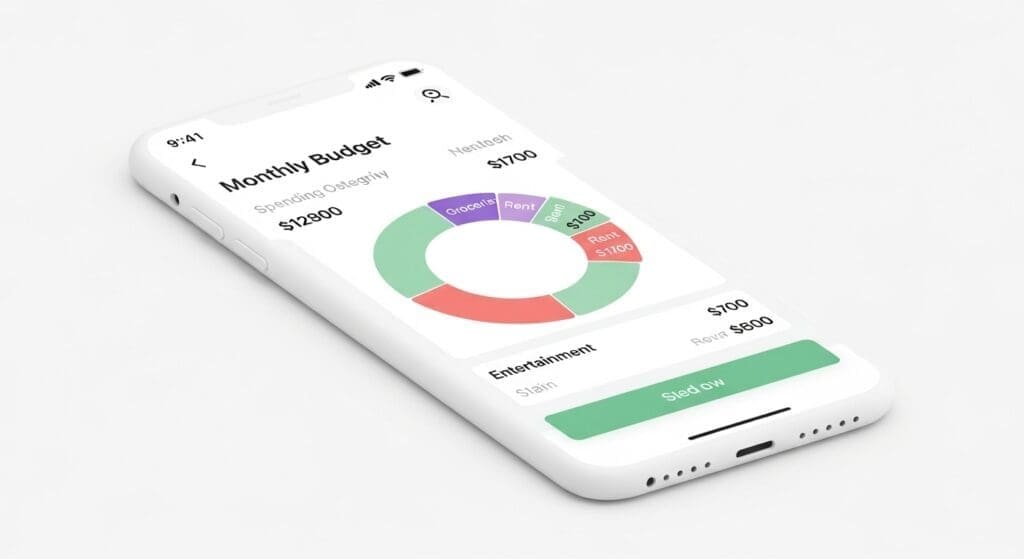
2. YNAB (You Need A Budget) – The Methodology Master
Cost: $14.99/month (Free for students for 12 months)
Best For: People serious about changing their financial habits
YNAB isn’t just an app—it’s a complete budgeting philosophy based on zero-based budgeting principles.
The YNAB Method:
- Give every dollar a job
- Embrace your true expenses
- Roll with the punches
- Age your money
Key Features:
- Zero-based budgeting framework
- Goal tracking and debt payoff planning
- Extensive educational resources
- Multi-currency support (perfect for Canadians)
- Real-time sync across devices
Success Statistics:
According to YNAB’s internal data, users save an average of $600 in their first two months and $6,000 in their first year.
Pros:
- Proven methodology with strong track record
- Excellent educational content
- Strong community support
- Canadian tax account recognition (TFSA, RRSP)
Cons:
- Requires manual transaction entry
- Steep learning curve
- Higher cost than competitors
3. PocketGuard – The Overspending Preventer
Cost: Free version available, Premium at $7.95/month
Best For: Chronic overspenders who need real-time spending guidance
PocketGuard focuses on one critical question: “How much can I safely spend right now?”
Key Features:
- “In My Pocket” calculation after bills and goals
- Automatic subscription detection
- Spending limit alerts
- Bill negotiation services (Premium)
- Simple, intuitive interface
How It Works:
The app analyzes your income, recurring bills, and financial goals to calculate your available spending money in real-time.
Pros:
- Prevents overspending effectively
- Identifies forgotten subscriptions
- Clean, simple interface
- Helpful spending insights
Cons:
- Limited investment tracking
- Fewer banks supported than Mint
- Basic reporting features
4. Personal Capital – The Wealth Tracker
Cost: Free (with optional paid advisory services)
Best For: People with investments or high net worth
Personal Capital combines budgeting with comprehensive wealth management tools.
Key Features:
- Net worth tracking across all accounts
- Investment performance analysis
- Retirement planning calculator
- Fee analyzer for investment accounts
- Cash flow tracking
Target Users:
While free for everyone, Personal Capital is most valuable for users with $100,000+ in investable assets.
Pros:
- Comprehensive investment tracking
- Professional-grade analytics
- Free retirement planning tools
- Strong security measures
Cons:
- Less focus on day-to-day budgeting
- Can be overwhelming for beginners
- Limited Canadian bank support
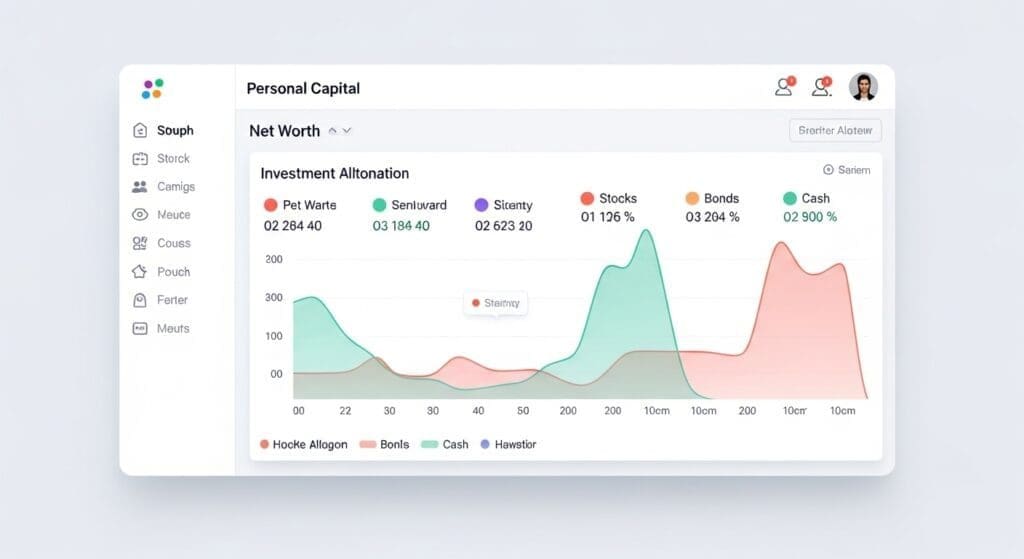
5. Goodbudget – The Digital Envelope System
Cost: Free for 10 envelopes, $8/month for unlimited
Best For: Couples and families who prefer envelope budgeting
Goodbudget digitizes the traditional envelope budgeting method, making it perfect for shared household budgeting.
Key Features:
- Digital envelope system
- Shared budgets across multiple devices
- Debt tracking and payoff planning
- Manual transaction entry (by design)
- Detailed reporting
Why It Works for Couples:
Real-time synchronization means both partners always see current envelope balances, preventing overspending and budget conflicts.
Pros:
- Excellent for shared budgeting
- Time-tested envelope methodology
- No automatic transaction import (some prefer this)
- Strong debt payoff tools
Cons:
- Manual entry required
- Limited automation
- Smaller user community
6. Tiller – The Spreadsheet Lover’s Dream
Cost: $6.58/month (annual billing)
Best For: People who love spreadsheets but want automated data feeds
Tiller automatically feeds your financial data into customizable Google Sheets or Excel templates.
Key Features:
- Automated data feeds to spreadsheets
- Customizable templates
- Advanced reporting capabilities
- Full control over categorization
- Canadian tax preparation templates
Why Spreadsheet Users Love It:
You get the automation of modern apps with the flexibility and power of spreadsheets.
Pros:
- Ultimate customization
- Powerful reporting capabilities
- One-time setup, minimal ongoing cost
- Excellent for detailed analysis
Cons:
- Requires spreadsheet knowledge
- Setup can be complex
- Limited mobile experience
7. Simplifi by Quicken – The Quicken Evolution
Cost: $5.99/month
Best For: Former Quicken users wanting cloud-based solutions
Simplifi offers modern budgeting with the reliability of the Quicken brand.
Key Features:
- Clean, modern interface
- Automatic categorization
- Goal tracking and planning
- Bill management
- Investment tracking
Migration Benefits:
Designed for users transitioning from desktop financial software to cloud-based solutions.
Pros:
- Intuitive interface
- Reliable bank connections
- Strong customer support
- Regular feature updates
Cons:
- Monthly fee for full features
- Limited free version
- Newer platform (fewer reviews)
8. Wally – The Minimalist’s Choice
Cost: Free
Best For: People who want simple expense tracking without complexity
Wally focuses on core expense tracking with a beautiful, minimalist interface.
Key Features:
- Photo receipt capture
- Simple categorization
- Location-based tracking
- Multi-currency support
- Clean, uncluttered design
Philosophy:
Sometimes less is more. Wally proves that effective budgeting doesn’t require dozens of features.
Pros:
- Completely free
- Beautiful, simple interface
- Quick transaction entry
- No overwhelming features
Cons:
- Limited advanced features
- No automatic bank sync
- Basic reporting
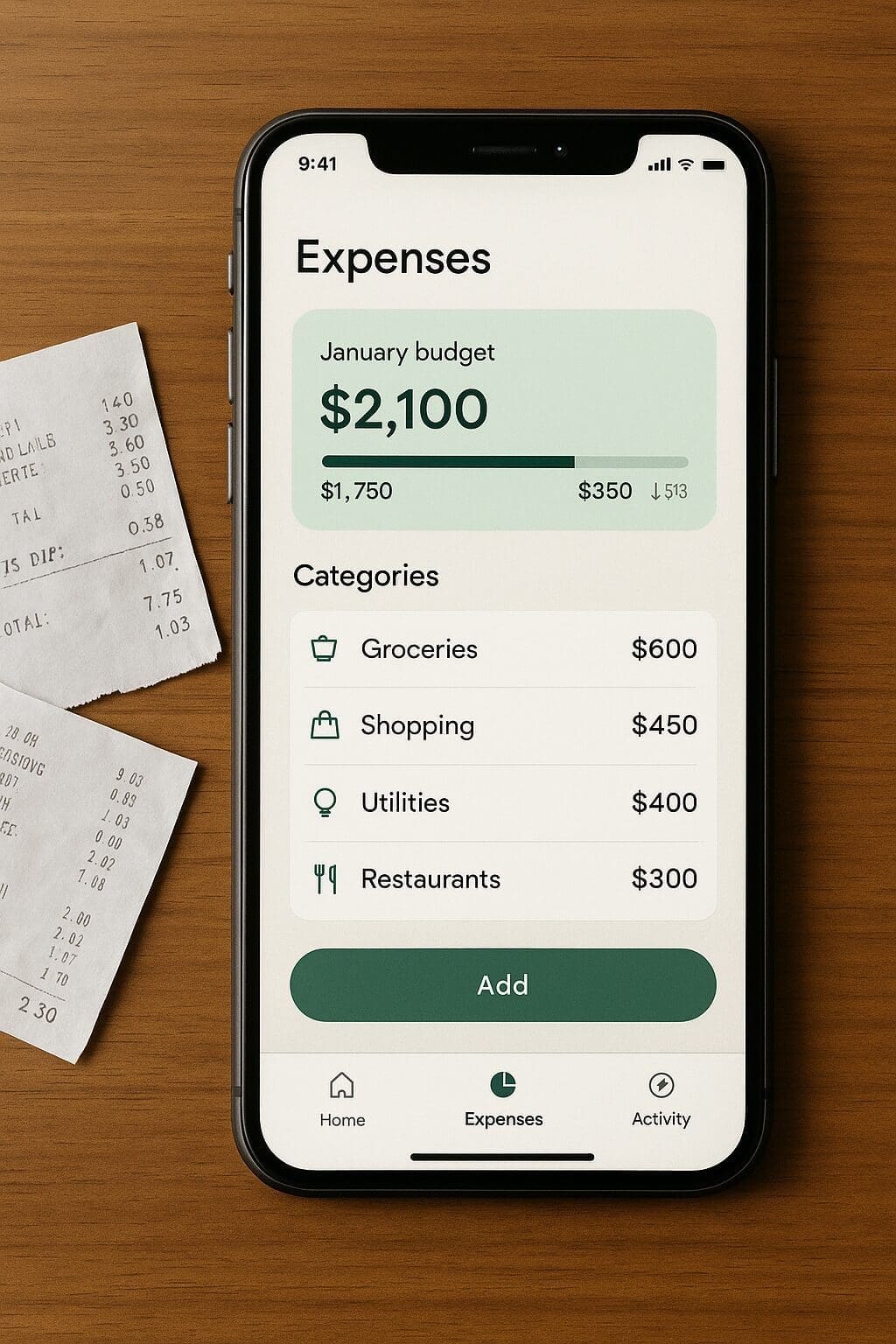
9. Cleo – The AI-Powered Coach
Cost: Free basic version, $5.99/month for premium
Best For: Millennials and Gen Z who want personality in their budgeting
Cleo uses artificial intelligence to provide personalized financial advice through conversational interactions.
Key Features:
- AI-powered spending insights
- Automatic savings features
- Bill negotiation services
- “Roast mode” for brutally honest feedback
- Spending predictions
The AI Advantage:
Cleo learns your patterns and provides increasingly personalized advice over time.
Pros:
- Engaging, conversational interface
- Automatic savings features
- Bill negotiation services
- Constantly improving AI
Cons:
- Limited advanced budgeting features
- Primarily mobile-focused
- Smaller institution support
10. CountAbout – The Comprehensive Alternative
Cost: $9.99/month
Best For: Users who need detailed reporting and analysis
CountAbout provides desktop-level functionality in a web-based platform.
Key Features:
- Detailed transaction management
- Advanced reporting capabilities
- Data import from Quicken and Mint
- Investment tracking
- Tax preparation support
Migration Friendly:
Designed to import data from other platforms, making switching painless.
Pros:
- Comprehensive feature set
- Excellent reporting
- Data portability
- Strong security
Cons:
- Higher monthly cost
- Steeper learning curve
- Interface less modern than competitors
Complete App Comparison Table
| App | Monthly Cost | Best Feature | Bank Connectivity | Investment Tracking | Canadian Support | Security Rating |
|---|---|---|---|---|---|---|
| Mint | Free | Comprehensive free features | Excellent (16,000+ institutions) | Basic | Full | A+ |
| YNAB | $14.99 | Zero-based budgeting method | Good (manual entry) | None | Excellent | A+ |
| PocketGuard | $7.95 | Real-time spending limits | Good | None | Limited | A |
| Personal Capital | Free | Investment tracking | Excellent | Comprehensive | Limited | A+ |
| Goodbudget | $8.00 | Envelope system | None (manual entry) | None | Full | A |
| Tiller | $6.58 | Spreadsheet automation | Excellent | Advanced | Good | A+ |
| Simplifi | $5.99 | Modern interface | Excellent | Basic | Good | A |
| Wally | Free | Minimalist design | None (manual entry) | None | Good | B+ |
| Cleo | $5.99 | AI insights | Good | None | Limited | A |
| CountAbout | $9.99 | Detailed reporting | Excellent | Good | Good | A+ |

Choosing the Right App for Your Situation
By User Type
College Students:
- Best Choice: Mint (free) or YNAB (free for students)
- Why: Comprehensive features without monthly fees
Young Professionals:
- Best Choice: PocketGuard or Simplifi
- Why: Modern interface with spending control features
Families:
- Best Choice: Goodbudget or YNAB
- Why: Shared budgeting and goal tracking
High Earners/Investors:
- Best Choice: Personal Capital or Tiller
- Why: Advanced investment tracking and detailed analysis
Minimalists:
- Best Choice: Wally or Cleo
- Why: Simple, uncluttered experience
By Primary Goal
Debt Payoff:
- Top Pick: YNAB or Goodbudget
- Features: Debt snowball/avalanche tracking, motivation tools
Saving Money:
- Top Pick: PocketGuard or Mint
- Features: Spending alerts, subscription detection
Investment Growth:
- Top Pick: Personal Capital or Tiller
- Features: Portfolio analysis, fee optimization
Family Budgeting:
- Top Pick: Goodbudget or YNAB
- Features: Shared access, category management
[INTERNAL LINK PLACEHOLDER: Link to debt payoff strategies article]
Canadian Users: Special Considerations
Banking Compatibility
According to the Financial Consumer Agency of Canada, Canadians should verify app compatibility with their specific institutions:
Full Canadian Support:
- Mint: Works with all Big 6 banks plus major credit unions
- YNAB: Manual entry works with any Canadian institution
- Goodbudget: Manual entry supports any bank
Limited Canadian Support:
- Personal Capital: Limited to major banks only
- PocketGuard: Some credit unions not supported
- Tiller: Good coverage but varies by institution
Tax-Advantaged Accounts
Canadian users should prioritize apps that recognize:
- TFSA (Tax-Free Savings Account) contributions and withdrawals
- RRSP (Registered Retirement Savings Plan) tracking
- RESP (Registered Education Savings Plan) management
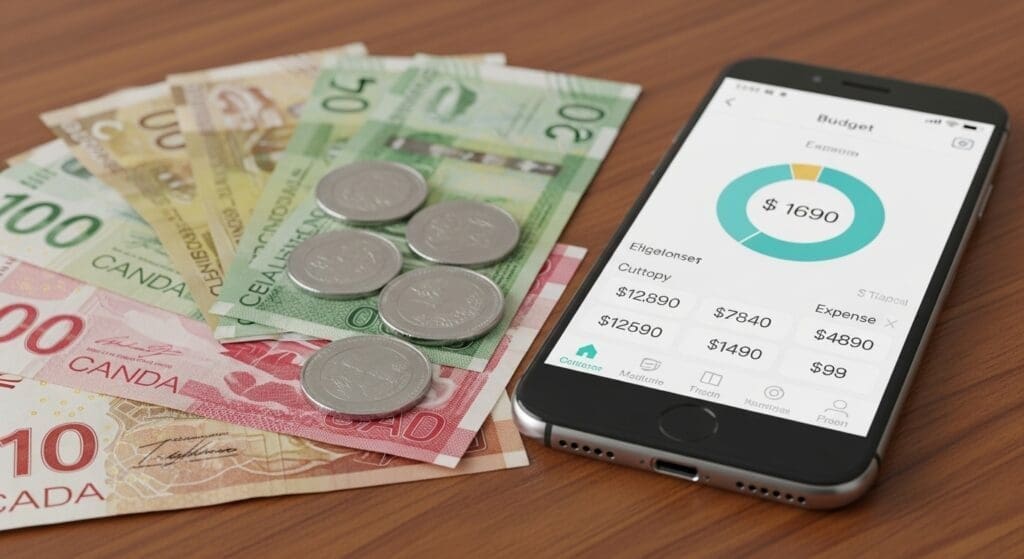
How I Would Secure My Financial Future With a $7,000 TFSA Investment
Security and Privacy Guide
Essential Security Features
According to cybersecurity guidelines from the FTC, look for:
Must-Have Security:
- 256-bit encryption (bank-level security)
- Two-factor authentication
- Read-only account access
- SOC 2 Type II certification
Red Flags:
- Requesting full banking passwords
- Unclear data usage policies
- No mention of encryption standards
- Suspicious app store reviews
Privacy Considerations
Data Usage:
- Free apps often monetize through anonymized data sales
- Premium apps typically rely on subscription revenue
- Always read privacy policies before linking accounts
Canadian Privacy Rights:
Under PIPEDA, Canadian users have the right to:
- Know how their data is used
- Request data deletion
- Receive breach notifications
Implementation Strategy
Week 1: Foundation Setup
- Choose one app based on your primary needs
- Link your main checking account only
- Set up basic categories (5-7 maximum to start)
- Enter your first month’s budget estimates
Week 2: Habit Formation
- Check the app daily (set phone reminders)
- Record cash transactions immediately
- Don’t worry about perfect categorization
- Adjust budget amounts as you learn actual spending
Week 3: Optimization
- Link remaining accounts
- Analyze spending patterns from first two weeks
- Set up one specific savings goal
- Explore premium features if using freemium app
Week 4: Advanced Features
- Customize categories to match your lifestyle
- Set up bill reminders
- Review and adjust budget based on real data
- Decide on premium upgrade if needed
Debt Avalanche vs. Snowball in 2025 — Which Pay-Off Method Really Saves You More?
Common Mistakes to Avoid
1. App Overload
Mistake: Downloading multiple apps “just to compare”
Solution: Choose one and commit for 30 days minimum
2. Perfectionism Paralysis
Mistake: Waiting for the “perfect” setup before starting
Solution: Start with basic categories and refine over time
3. Ignoring Mobile Experience
Mistake: Choosing based on desktop features only
Solution: Test mobile app thoroughly (you’ll use it 80% of the time)
4. Subscription Creep
Mistake: Forgetting about app subscriptions after free trials
Solution: Set calendar reminders before trial periods end
5. Over-Categorization
Mistake: Creating 20+ spending categories immediately
Solution: Start with 5-7 broad categories, add detail gradually
Frequently Asked Questions
Are free budgeting apps really free?
Most free apps generate revenue through advertising or by selling anonymized spending data for market research. According to Privacy Rights Clearinghouse, this is legal as long as data is anonymized and users consent. Read privacy policies carefully to understand data usage.
Should I link all my accounts immediately?
Start with one main account to test the app’s functionality and your comfort level. The Consumer Financial Protection Bureau recommends gradual account linking to minimize risk exposure.
How secure are these apps compared to online banking?
Reputable budgeting apps use the same 256-bit encryption as banks. However, they add an additional layer between you and your financial institution. Apps with read-only access (like Mint and Personal Capital) are generally safer than those requiring your banking passwords.
Can I switch apps without losing data?
Most apps allow data export, but formats vary. Tiller and CountAbout offer the best data portability. Always export your data before canceling any service.
Do these apps affect my credit score?
No, budgeting apps don’t directly impact credit scores. However, some apps (like Mint) perform “soft pulls” to show you your credit score, which doesn’t affect your rating.
Which app works best for irregular income?
YNAB excels for irregular income because it focuses on budgeting money you already have rather than predicting future income. Freelancers and commission-based workers often prefer this approach.

Take Control of Your Financial Future
The best budgeting app is the one you’ll actually use every day. Based on our comprehensive analysis, here are our top recommendations:
Best Overall Value: Mint (Free, comprehensive features)
Best for Serious Budgeters: YNAB ($14.99/month, proven methodology)
Best for Overspenders: PocketGuard ($7.95/month, real-time limits)
Best for Investors: Personal Capital (Free, investment tracking)
Best for Couples: Goodbudget ($8/month, shared envelopes)
Stop wondering where your money goes and start taking control today. Choose one app, download it right now, and link just one account. Your future self will thank you for taking this first step toward financial freedom.
Ready to transform your finances? Pick your app and start your journey to financial confidence today.
Want to Keep Strengthening Your Finances?
If you found this article helpful, you might enjoy some of our other popular posts that dive deeper into saving, investing, and smart money management:
- 6 Financial Strategies to Protect Your Wealth
- Best No-Penalty CD Rates of 2025
- Best High-Yield Savings Accounts 2025
- 8 Powerful Financial Strategies Every Single Person Should Know
- The 10 Best Financial Wellness Apps That Track Mental Health in 2025
- 2025 401(k) Limits: Save $34,750 + Super Catch-Up Guide
Keep exploring — your smartest financial years are just getting started.
External Sources Referenced
- LendingClub Paycheck-to-Paycheck Report 2024
- Federal Reserve Economic Well-Being Report 2024
- FDIC Survey of Household Use of Banking 2021
- Mint by Intuit
- YNAB Official Website
- PocketGuard
- Personal Capital
- Goodbudget
- Tiller
- Simplifi by Quicken
- Wally
- Cleo
- CountAbout
- Financial Consumer Agency of Canada
- FTC Cybersecurity Guidelines
- Privacy Commissioner of Canada – PIPEDA
- Consumer Financial Protection Bureau
- Privacy Rights Clearinghouse
Disclaimer: This article is for educational purposes only and does not constitute personalized financial advice. App features and pricing may change; verify current information on official websites before making financial decisions. Always consult with a qualified financial advisor for personalized guidance.
